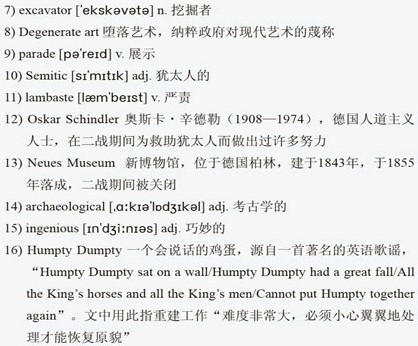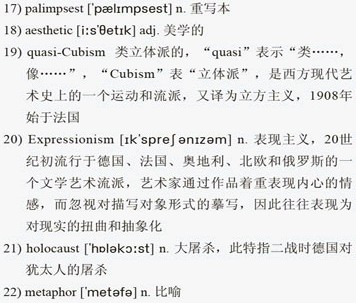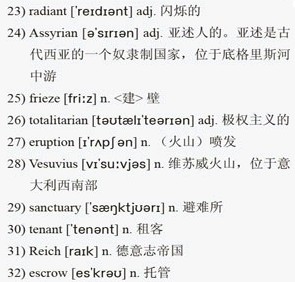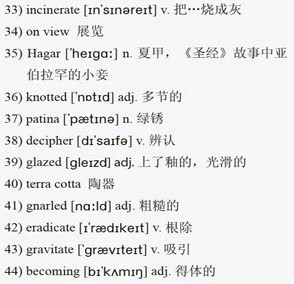文字难度:★★★
The past still 1)thrusts itself back into the headlines here, occasionally as an unexploded bomb turning up somewhere. Now it has reappeared as art.
历史旧事依然挤进当地的头条新闻,有时候就像一个在某处突然出现的未引爆炸弹。现在这段历史又以艺术的形式再次出现在我们面前。
In last January workers digging for a new subway station near City Hall unearthed a bronze 2)bust of a woman, 3)rusted, 4)filthy and almost unrecognizable. It 5)tumbled off the shovel of their front-loader.
去年一月份,工人们为修建一个新的地铁站而在市政厅附近开挖时,挖掘出了一座半身女铜像,其锈迹斑斑,肮脏不堪,几乎无法辨认。当时,这个铜像从挖土机的铲斗中滚落了下来。
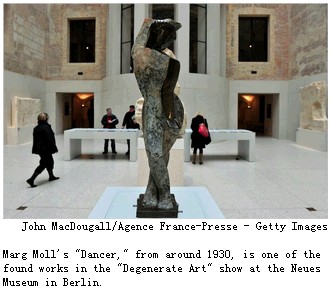 Researchers learned the bust was a portrait by Edwin Scharff, a nearly forgotten German modernist, from around 1920. It seemed6)anomalous until August, when more sculpture emerged nearby: “Standing Girl” by Otto Baum, “Dancer” by Marg Moll and the remains of a head by Otto Freundlich. 7)Excavators also rescued another fragment, a different head, belonging to Emy Roeder’s “Pregnant Woman.”
Researchers learned the bust was a portrait by Edwin Scharff, a nearly forgotten German modernist, from around 1920. It seemed6)anomalous until August, when more sculpture emerged nearby: “Standing Girl” by Otto Baum, “Dancer” by Marg Moll and the remains of a head by Otto Freundlich. 7)Excavators also rescued another fragment, a different head, belonging to Emy Roeder’s “Pregnant Woman.”
研究人员发现,这个半身铜像出自埃德文·沙尔夫之手,他是一位几乎被遗忘了的德国现代主义艺术家,该铜像大概是其1920年的作品。这个发现一直让人觉得很不寻常,直到八月份,更多的雕像在发掘现场附近被挖出:奥托·鲍姆的“站着的女孩”, 马格·莫尔的“舞者”以及奥托·弗伦德里希的某个雕像头部的残余部分。发掘者还出土了另一块残缺雕塑头部残余部分,是属于埃米·略德尔的雕像“孕妇”的。
The 11 sculptures proved to be survivors of Hitler’s campaign against what the Nazis notoriously called“8)degenerate art.” Several works, records showed, were seized from German museums in the 1930s, 9)paraded in the fateful “Degenerate Art” show, and in a couple of cases also exploited for a 1941 Nazi film, an anti- 10)Semitic comedy 11)lambasting modern art. Then the sculptures vanished.
这11尊雕像经证实是当年希特勒政府打压运动中幸存下来的作品,当时希特勒纳粹政府污蔑这些为“堕落艺术”并对其进行打压。据资料记载,其中几件作品在上世纪30年代被纳粹党人从德国数间博物馆中抢夺出来,然后在臭名昭著的“堕落艺术”展览中被嘲讽示众,同时还于1941年被用来拍摄一部反犹太的纳粹喜剧,该剧充斥了对现代艺术的抨击。之后,这些雕塑突然消失无踪。
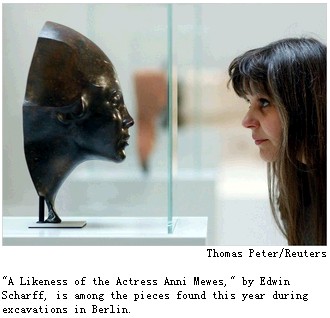 How they ended up underground near City Hall is still a mystery; it seems to involve an 12)Oskar Schindler-like hero. Meanwhile a modest exhibition of the discoveries has been organized and opened at the 13)Neues Museum, Berlin’s 14)archaeological collection, the perfect site for these works.
How they ended up underground near City Hall is still a mystery; it seems to involve an 12)Oskar Schindler-like hero. Meanwhile a modest exhibition of the discoveries has been organized and opened at the 13)Neues Museum, Berlin’s 14)archaeological collection, the perfect site for these works.
这些雕塑如何最终埋藏在市政厅的地底下依然是个谜;这似乎离不开一个奥斯卡·辛德勒之类的英雄。与此同时,人们为这些出土文物策划了一场小型的展览,在柏林新博物馆中展出,该博物馆专门收藏考古文物,是这些作品的最佳安身之所。
Like the sculptures, the museum lately rose, all these years later, from the ruins of war. In the architect David Chipperfield’s 15)ingenious, 16)Humpty Dumpty-like reconstruction of the building, it has become a popular 17)palimpsest of German history, bearing witness, via the evidence of the damage done to it, to a violence that not even time and several generations have been able to erase.
和这些雕塑一样,该博物馆最近也从战争的废墟中重获新生。经建筑师大卫·切波菲尔德独具匠心,小心翼翼的设计重建,新博物馆成为了德国著名的历史建筑和历史见证,用它伤痕累累的身躯,提醒着人们,它所经历的暴行甚至是时间和几代人都无法抹去。
I can hardly express how moving this little show is, unexpectedly so. Its effect ends up being all out of proportion to the objects discovered, which are, in strictly 18)aesthetic terms, fine but not remarkable. They are works of 19)quasi-Cubism or 20)Expressionism, mostly not much more than a foot high, several newly cleaned but still scarred, inspiring the obvious human analogy.
我无法形容这场小型展览是多么的让人感动,出乎意外地让人感动。它所产生的影响远大于这些被发现的雕塑本身,其实这些雕塑从严格的美学角度看,只能算是精美,但还没达到非常优秀的程度。这些作品属于类立体派或印象派,大部分只有一英尺多高(约0.3米),有些虽然刚刚清洗过,但是依旧伤痕累累,所触发的譬喻意味显而易见。
The poet and 21)Holocaust survivor Paul Celan came up, in a different context, with the 22)metaphor of bottles tossed into the ocean “at the shoreline of the heart,” now finally washed ashore. They’re like the dead, these sculptures, ever coming back to us, 23)radiant ghosts.
保罗·策兰,是诗人,也是大屠杀的幸存者之一,想到一个不同的比喻,那些在“心灵海岸线”上投入大海的漂流瓶现在最终被冲上了岸。这些雕塑就像逝者,其闪烁的灵魂回到我们的面前。
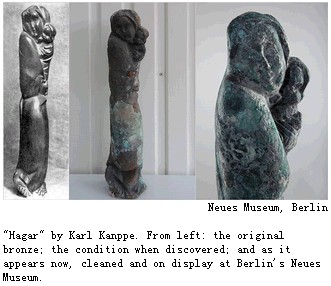 In a country that for decades has been profoundly diligent at disclosing its own crimes and framing them in the context of history, it makes sense that the exhibition was installed to share a courtyard with 24)Assyrian 25)friezes from a long-ago regime that made an art of 26)totalitarian rule and with an ancient frieze describing the 27)eruption of 28)Vesuvius, which preserved priceless objects, buried in the ash, that have found 29)sanctuary in institutions like the Neues Museum.
In a country that for decades has been profoundly diligent at disclosing its own crimes and framing them in the context of history, it makes sense that the exhibition was installed to share a courtyard with 24)Assyrian 25)friezes from a long-ago regime that made an art of 26)totalitarian rule and with an ancient frieze describing the 27)eruption of 28)Vesuvius, which preserved priceless objects, buried in the ash, that have found 29)sanctuary in institutions like the Neues Museum.
数十年来,德国一直不断地深入揭露自己曾经犯下的罪行并将其写进历史,因此,在这样的一个国家里,举办这个展览时将展品与其他同类型的展品陈列在同一展厅里就不足为奇了。其他展品包括数块来自文明古国的亚述人岩壁浮雕——极权主义统治的艺术表现,以及一块描述维苏威火山爆发的古旧壁雕——无数珍品因被火山灰掩埋而得以保存下来,而之后被发现并最终安身于诸如新博物馆这样的机构中。
Archeologists have so far determined that the recovered works must have come from 50 Königstrasse, across the street from City Hall. The building belonged to a Jewish woman, Edith Steinitz; several Jewish lawyers are listed as her 30)tenants in 1939, but their names disappear from the record by 1942, when the house became property of the 31)Reich. Among its subsequent occupants, German investigators now believe, the likeliest candidate to have hidden the art was Erhard Oewerdieck, a tax lawyer and 32)escrow agent.
考古学家目前已确定这些重见天日的艺术品来自国王街50号,与市政厅一街之隔。这座建筑属于一个名叫艾迪斯·斯坦尼兹的犹太女人;根据资料记载,1939年,一些犹太律师曾经租住在这里,但自从这座房子在1942年被德意志政府收归国有后,他们的名字就从记录上消失了。德国的调查人员现在认为,在后来的住客中,最有可能把这些艺术品藏起来的人是艾哈德·欧文德克,他是一名税务律师以及托管代理人。
Oewerdieck is not widely known, but he is remembered at Yad Vashem, the Holocaust memorial in Israel. In 1939, he and his wife gave money to a Jewish family to escape to Shanghai. He also hid an employee, Martin Lange, in his apartment. The current theory is that when fire from Allied air raids in 1944 consumed 50 Königstrasse, the contents of Oewerdieck’s office fell through the floor, and then the building collapsed on top. Tests are being done on ash from the site for remains of 33)incinerated paintings and wood sculptures. How the lost art came into Oewerdieck’s possession in the first place still isn’t clear.
欧文德克并非名满天下,但是他却被铭记于雅瓦限——以色列的大屠杀纪念馆。1939年,他和妻子资助了一个犹太家庭逃往上海。他还把一个名叫马丁·拉恩格的雇员藏在自己的住所。目前有一种看法认为,在1944年盟军空袭摧毁国王街50号时,欧文德克办公室里的物品通过地板掉入了地下,然后整座建筑都倒塌了并盖在上面。研究人员正在检验从现场带回的灰,看看有没有油画和木雕的灰烬残存。至于欧文德克是如何获得这些丢失的艺术品的,现在仍没有定论。
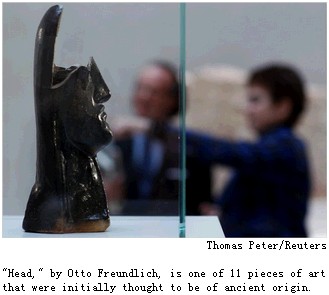 But at least it’s now back 34)on view. Scharff’s bust, of an actress named Anni Mewes, brings to mind Egyptian works in the Neues Museum. Karl Knappe’s “35)Hagar,” a bronze from 1923, twisted like 36)knotted rope, has been left with its green 37)patina of rust and rubble, making it almost impossible to 38)decipher, save as evidence of its fate. On the other hand, Freundlich’s “Head,” from 1925, a work made of 39)glazed 40)terra cotta, 41)gnarled like an old olive tree, loses little of its power for being broken.
But at least it’s now back 34)on view. Scharff’s bust, of an actress named Anni Mewes, brings to mind Egyptian works in the Neues Museum. Karl Knappe’s “35)Hagar,” a bronze from 1923, twisted like 36)knotted rope, has been left with its green 37)patina of rust and rubble, making it almost impossible to 38)decipher, save as evidence of its fate. On the other hand, Freundlich’s “Head,” from 1925, a work made of 39)glazed 40)terra cotta, 41)gnarled like an old olive tree, loses little of its power for being broken.
不过至少这些艺术品又能重见世面了。沙尔夫的半身铜像是依照一位名为安妮·米尔斯的女演员而创作的,它使人联想到新博物馆里的那些埃及艺术品。卡尔·纳帕的“夏甲”,一个1923年的铜质雕像,扭曲得像一团纠缠在一起的绳子,布满了绿色的铜锈和碎石瓦砾,几乎无法让人辨认,锈迹泥斑留着作为其命运的见证。另一方面,弗伦德里希于1925年创作的雕像“头”,这件上了釉的陶器粗糙得像一棵老橄榄树,即使碎裂却依然充满力量。
Across the street from the Neues Museum contemporary galleries showcase the sort of work the Nazis hoped to 42)eradicate but that instead give Berlin its current identity as a capital of cool. This is a city that resembles the young masses who 43)gravitate here: forever in a state of 44)becoming, wary, unsure and unresolved, generally broke, but optimistic about the future, with the difference that Germany can’t escape its past.
在街道的另一边,新博物馆的对面,当代艺术画廊陈列了纳粹党人曾企图毁灭的艺术品,而这些艺术品却赋予了柏林独特的个性,使其成为让人赞叹的艺术之都。这个城市就像那些被吸引到这里来的年轻人那样:永远都大方得体、谨小慎微、不是很自信、摇摆不定,而且大都身无分文,但却对未来保持乐观,不同的是德国无法摆脱它的过去。


